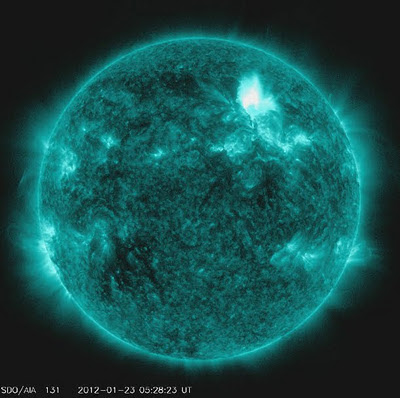sun unleashes mass coronal ejection and blasts earth with radiation
DOUBLE-BARRELED SOLAR EVENT
JANUARY 19, 2012
An active region on the Sun unleashed two blasts in quick succession (Jan. 19, 2012), which have sent particle clouds headed towards Earth. The images combine the wider field of view from SOHO's C2 coronagraph with the Sun itself as seen in extreme UV light by Solar Dynamics Observatory (SDO). The initial burst above the Sun is from the far side of the Sun and not headed our way. The next two bursts, one quickly following the other, are from the bright active region seen near the 10 o'clock position. A series of coronal loops rise up above the active region after these events. The impact on the geomagnetic storm Earth may cause some bright auroras. The video covers about 24 hours of activity.
visit page for video <<< link will need to be updated beacause it is "pick of the week"
> SOHO Pick of The Week
see also
• ESA Portal - Solar storm heading toward Earth
contains a great flash loop showing events january 20-23 including a dramatic particle storm at the end
(The end of the movie shows the interference caused by the onslaught of fast, energetic solar particles emitted from the sun.)
M8.7 class solar flare
January 22, 2012
M8.7 Close-Up
This closeup still of the January 22, 2012, M8.7 class solar flare was taken by the Solar Dynamics Observatory (SDO) in 304 angstrom. An earth-directed coronal mass ejection (CME) accompanied the flare. Credit: NASA/SDO
solar energetic particle" event
 Solar Dynamics Observatory captured the flare, shown here in teal as that is the color typically used to show light in the 131 Angstrom wavelength, a wavelength in which it is easy to view solar flares. The flare began at 10:38 PM ET on Jan. 22, peaked at 10:59 PM and ended at 11:34 PM. Credit: NASA/SDO/AIA | go to page for video
Solar Dynamics Observatory captured the flare, shown here in teal as that is the color typically used to show light in the 131 Angstrom wavelength, a wavelength in which it is easy to view solar flares. The flare began at 10:38 PM ET on Jan. 22, peaked at 10:59 PM and ended at 11:34 PM. Credit: NASA/SDO/AIA | go to page for video
The sun erupted late on January 22, 2012 with an M8.7 class flare, an earth-directed coronal mass ejection (CME), and a burst of fast moving, highly energetic protons known as a "solar energetic particle" event. The latter has caused the strongest solar radiation storm since September 2005 according to NOAA's Space Weather Prediction Center.
NASA's Goddard Space Weather Center's models predict that the CME is moving at almost 1,400 miles per second, and could reach Earth's magnetosphere – the magnetic envelope that surrounds Earth -- as early as tomorrow, Jan 24 at 9 AM ET (plus or minus 7 hours). This has the potential to provide good auroral displays, possibly at lower latitudes than normal.
NASA - M8.7 Solar Flare and Earth Directed CME
earth directed coronal mass ejection arrives
January 24, 2012
The coronal mass ejection (CME) collided with Earth's magnetic field a little after 10 AM ET on January 24, 2012. The influx of particles from the CME amplified the solar radiation storm such that it is now considered the largest since October 2003. NOAA's Space Weather Prediction Center has categorized it as a "strong" -- or S3 (with S5 being the highest) – storm. Solar radiation storms can affect satellite operations and short wave radio propagation, but cannot harm humans on Earth. Auroras may well be visible tonight at higher latitudes such as Michigan and Maine in the U.S., and perhaps even lower.
This closeup of the January 22, 2012, M8.7 class solar flare was taken by the Solar Dynamics Observatory (SDO) in 304 angstrom. An earth-directed coronal mass ejection (CME) accompanied the flare.
Space Weather Alerts and Warnings Timeline

jan 20 - 25, 2011
NASA's Cosmicopia -
- Sun - Solar Activity - Solar Flares
A solar flare is an enormous explosion in the solar atmosphere. It results in sudden bursts of particle acceleration, heating of plasma to tens of millions of degrees, and the eruption of large amounts of solar mass. Flares are believed to result from the abrupt release of the energy stored in magnetic fields in the zone around sunspots.
There are two types of flares: impulsive and gradual. Impulsive flares accelerate mostly electrons, with some protons. They last minutes or hours and the majority appear near the solar equator. Impulsive flares occur at a rate of about 1000 per year during solar maximum.
Gradual flares accelerate electrons, protons, and heavy ions to near the speed of light, and the events tend to last for days. They occur mainly near the poles of the Sun and happen about 100 times per year.
This acceleration of solar flare particles to extremely high energies involves all the different elements in the solar atmosphere. Ions of elements such as carbon, nitrogen, oxygen, neon, magnesium, silicon, and iron, excited in this way, end up in solar cosmic rays, also called solar energetic particles (SEPs)...
new solar cycle ramping up
 This artist concept shows the interaction between the sun and Earth's magnetosphere. The magnetosphere deflects most solar and cosmic radiation, but lets more in at the poles. Credit: NASA
This artist concept shows the interaction between the sun and Earth's magnetosphere. The magnetosphere deflects most solar and cosmic radiation, but lets more in at the poles. Credit: NASA
Radiation constantly bombards the Earth, from the sun and in the form of cosmic background radiation from the universe at large. A magnetic field originating deep within the planet surrounds the Earth, deflecting much of the radiation. At the poles, however, radiation has an opening to the planet's atmosphere. People on the ground are safe from this radiation, but are subject to more hazardous levels at the altitude where jets fly.
The new solar cycle is ramping up. This image from NASA's Solar Dynamics Observatory shows the sun emitting its first X-class flare in more than four years Feb. 14, 2011. X-class flares are the most powerful of all solar events and can trigger radio blackouts and long-lasting radiation storms. This particular flare comes on the heels of a several other recent flares. Credit: NASA/Goddard Space Flight Center
NASA - Thousand-fold Rise in Polar Flights Hikes Radiation Risk
Space Weather Alerts
NOAA / NWS Space Weather Prediction Center |
Space Weather Alerts from SWPC
2012-01-25 21:00 Conditions Now Trending Back Towards Normal
After the arrival of a CME yesterday and the subsequent activity which ensued, conditions are now beginning to trend back towards quiet levels. We are continuing to monitor the source region that produced this week's activity as it moves to rotate off the visible disk of the sun in the next few days. For more information, you can also follow us on Facebook.
Today's Space Weather
3-day Solar-Geophysical Forecast issued Jan 25 22:00 UTC
Solar Activity Forecast
Solar activity is expected to be very low to low during the period (26 - 28 January). A chance for M-class activity exists on 26 - 27 January from Regions 1401 and 1402 before they rotate around the west limb.
Geophysical Activity Forecast
The geomagnetic field is expected to be at mostly quiet levels on day one (26 January). By day two (27 January) and through day three (28 January), field activity is expected to increase to quiet to unsettled levels with isolated active periods. This increase in activity is due to a recurrent coronal hole high speed stream expected to move into a geoeffective position. The greater than 10 MeV proton flux event is expected to remain above event levels through 26 January, falling to background levels by 27 January.
what if i was an astronaut?
solar protons accelerated to nearly light speed by the explosion reach the Earth-Moon system minutes after the flare--the beginning of a days-long proton storm
Newt’s Moon Colony A Hit In Florida’s Space Coast
January 25, 2012: Newt Gingrich, courting voters in Florida’s NASA-heavy “Space Coast,” pledged to build an American lunar colony within eight years if elected president.
“By the end of my second term we will have the first permanent base on the moon and it will be American,” he said. According to Gingrich, the base would be used for “science, tourism, and manufacturing” and create a “robust industry” that would grow “precisely on the model of the airlines in the 1930s.”
The speech was a direct challenge to Mitt Romney, who has accused Gingrich of favoring big government with his past proposals for lunar exploration and colonization.
January, 2005: The biggest solar proton storm in 15 years erupted last week. NASA researchers discuss what it might have done to someone on the Moon.
NASA is returning to the Moon--not just robots, but people. In the decades ahead we can expect to see habitats, greenhouses and power stations up there. Astronauts will be out among the moondust and craters, exploring, prospecting, building.
Last week, though, there were no humans walking around on the Moon.
Good thing.
On January 20th, 2005, a giant sunspot named "NOAA 720" exploded. The blast sparked an X-class solar flare, the most powerful kind, and hurled a billion-ton cloud of electrified gas (a "coronal mass ejection") into space. Solar protons accelerated to nearly light speed by the explosion reached the Earth-Moon system minutes after the flare--the beginning of a days-long "proton storm."
Here on Earth, no one suffered. Our planet's thick atmosphere and magnetic field protects us from protons and other forms of solar radiation. In fact, the storm was good. When the plodding coronal mass ejection arrived 36 hours later and hit Earth's magnetic field, sky watchers in Europe saw the brightest and prettiest auroras in years: gallery.
The Moon is a different story.
"The Moon is totally exposed to solar flares," explains solar physicist David Hathaway of the Marshall Space Flight Center. "It has no atmosphere or magnetic field to deflect radiation." Protons rushing at the Moon simply hit the ground--or whoever might be walking around outside.
more > Sickening Solar Flares - NASA Science









































